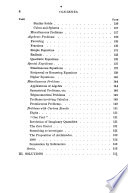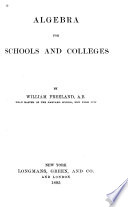 | John Bernard Clarke - Algebra - 1889 - 566 pages
...~product is made up as stated in the proposition. — mn 4- »* m 2 — 2m» 4- " 2 71. Theorem.—The product of the sum and difference of two quantities is equal to the difference of their squares. If a and 6 represent the quantities, show by direct multiplication that (a + b) (a—6) =... | |
 | John Kelley Ellwood - Algebra - 1892 - 300 pages
...first, plus the square of the second, minus twice the product of the two, or d' = A2 + Б2 — 2 p. The product of the sum and difference of two quantities is equal to the difference of their squares, or sd = A2 — B*. The chord of an angle is equal to twice the sine of half the angle. 18.... | |
 | Asa Hollister Craig - Examinations - 1897 - 538 pages
...however, the binomial be a residual the sign of the second term in the square should be minus. 41. The product of the sum and difference of two quantities is equal to the difference of their squares. 42. If the signs of terms are alike, prefix the plus sign to the quotient; if they are unlike,... | |
 | William James Milne - Algebra - 1894 - 216 pages
...difference of two quantities obtained from the quantities ? 2. What sign connects the terms ? 63. PRINCIPLE. The product of the sum and difference of two quantities is equal to the difference of their squares. Write the products of the following : 2. (m + гг) (та — n). 4. (2 a + b) (2 a -b). 5.... | |
 | William James Milne - Algebra - 1894 - 214 pages
...difference of two quantities obtained from the quantities ? 2. What sign connects the terms ? 63. PRINCIPLE. The product of the sum and difference of two quantities is equal to the difference of their squares. Write the products of the following : 1. (a + b)(a — 6). 13. (b + 2c)(b — 2c). 2. (m +... | |
 | Joseph Ray - Algebra - 1894 - 252 pages
...a-|- 6 represents the sum of two quantities, and a — b, their difference. Hence, Theorem III. — The product of the sum and difference of two quantities is equal to the difference of their squares. 1. (5+3)(5— 3)=25— 9=16=8x2. 2. (2a+6)(2a— 6)=4a2— V. 3. (2x+3y](2x—3y)^4iif—9y\... | |
 | William Freeland - Algebra - 1895 - 328 pages
...the first by the second, plus the square of the second. III. (a + b)(a - &) = a2 - V. That is : 64. The product of the sum and difference of two quantities is equal to the difference of their squares. Applying the principles involved in these three theorems, perform the operations indicated... | |
 | William Milford Giffin - Algebra - 1895 - 136 pages
...2y) (lx-2y) 375. 374. (5* + (7 x 372. (4«-2 b) - 5*) 376. x 376a. Copy or read and fill the blanks. The product of the sum and difference of two quantities is equal to the _ of their ___ LESSON XXXVII. x + 4 eo + H CO FIG. 16. FIG. 18. 377. From the perimeter of Fig. 16... | |
 | Webster Wells - Algebra - 1897 - 384 pages
...to multiply a + b by a — b. a + b a — b a2 + ab -ab-b* Whence, (a + 6) (a - 6) = a2 -b*.That is, the product of the sum and difference of two quantities is equal to the difference of their squares. Example. Multiply 6 a2 + b by 6 a- — b. We have, (6 a2 + 6) (6 a2 - 6) = (6 a2)2 - 62 =... | |
 | Webster Wells - Algebra - 1897 - 386 pages
...to multiply a + b by a — b. a + b a — b a*+ab -ab- W Whence, (a + b) (a - b) = a2 - b2. That is, the product of the sum and difference of two quantities is equal to the difference of their squares. Example. Multiply 6 a* + b by 6 a? — b. We have, (6 a2 + b) (6 a2 - b) = (6 a2)2 - b2 =... | |
| |